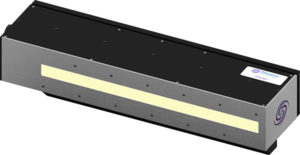Phoseon Technology believes it’s just a matter of time before UV LED cured low-migration inks, coatings and adhesives are widely adopted across global markets.
Low migration is a term used to describe the entire process of applying and curing specially formulated inks used in packaging such that there is minimal to no migration through the packaging materials and into the product. Low migration — also known as food safe process — is not exclusive to food packaging; it also extends to other products such as pharmaceuticals, cosmetics and pet products where uncured or migrating inks can negatively impact the product’s composition or odor.
“The UV output of LED curing equipment is much more stable over time compared with conventional mercury based systems. This results in greater process control when used to crosslink inks, coatings and adhesives in low-migration processes.”
Jennifer Heathcote, Global Business Development Manager, Phoseon Technology
Since 2004, EU Framework Regulation EC 1935/2004 requires low migration for all food packaging. While there are a variety of processes that can reduce migration levels, Phoseon Technology’s revolutionary UV-LED curing technology offers superior process stability and consistency, both top requirements for low-migration printing.
“The UV output of LED curing equipment is much more stable over time compared with conventional mercury based systems. This results in greater process control when used to crosslink inks, coatings and adhesives in low-migration processes,” said Jennifer Heathcote, Global Business Development Manager at Phoseon Technology.
UV LED curing is becoming increasingly more viable for decorating applications spanning printed labels, flexible and shrink films, rigid containers, and carton and corrugated board. In addition to its quick-drying capabilities, UV LED curing creates less heat transfer to the substrate, thereby, eliminating or significantly reducing any damage to the print surface.
“That’s a critical benefit, especially when printing on heat-sensitive plastic films often used in food packaging,” said Heathcote.
Heathcote notes that while there are upfront costs to switch to UV LED curing for food safe process printing, companies often quickly recoup their investment. UV LED curing technology has no moving or consumable parts which significantly reduces down-time for maintenance and repairs. UV LED systems last longer and can reduce energy consumption by up to 70 percent compared with traditional arc lamps. In addition, UV LED curing does not contain mercury, which is used in conventional lamps, making for a safer environment and workplace.
Tags: UV LED Curing for Low-Migration Printing | LEDinside Magazine | Low-Migration PackagingCategories: Printing, Flexo
